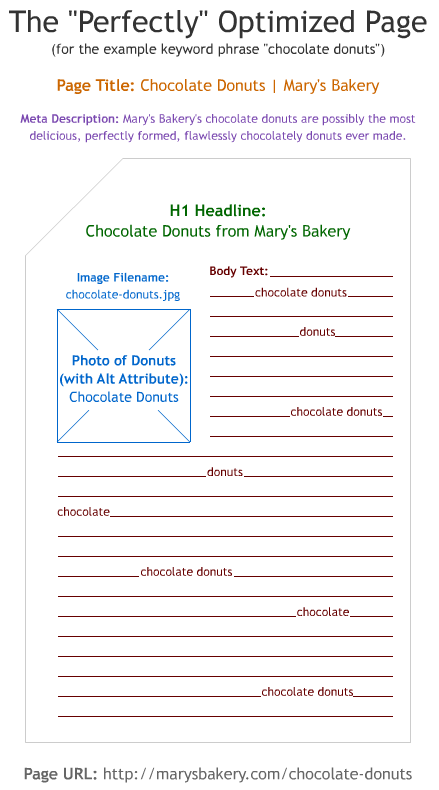SEO: Back to Basics
September 29, 2012 Leave a Comment
More often than not, good search engine optimisation is first and foremost about getting the basics right. Does your site have high quality, relevant and unique content? Is your site (and your content) technically well structured and easily accessible for search engine spiders? And is your content clearly signposted for both search engines and your users?
I still find in many instances, that getting the basics right in terms of on page optimisation can help many sites improve search engine rankings and visibility. An excellent reference point that illustrates these basics superbly well is an SEOmoz blog post from 2009 entitled: Perfecting Keyword Targeting & On-Page Optimization. The original post which uses research data to demonstrate the importance of these basics, also includes a very simple example page layout, copied below, which shows very clearly an ideally optimised page.
If you have the time, I strongly recommend reading the original post. However I’ve summarised some of the most important points here:
1. Page Meta Title.
Quite simply this is the single most important of all the on-page keyword elements. The page meta title should ideally employ the target keyword or search phrase as the first word(s). Not only is this proven to help rankings but also means that the searcher sees the term they searched in the title of the search result snippet.
2. Page Meta Description.
The page meta description is not used for “rankings” by Google, but is still an important place to use the target search term or phrase due to the “bolding” of the words that appear in the visual snippet of the search results, and because it has also been shown to help boost click-through rate.
3. H1 Headline tag
The H1 tag has always been thought to have great importance in on-page optimisation, and although the original post did question this, it still advised the proper use of a single H1 tag as the headline of the page, preferably including the targeted keyword term or phrase.
4. Image Alt Tag Attribute
The SEOmoz study showed that the image alt tag, previously thought to carry little SEO weight, actually had a reasonably robust correlation with high rankings. It is strongly recommended to use a graphic image/photo/illustration on important keyword-targeted pages with the search term or phrase used in the alt tag. It is also suggested to use the keyword term or phrase as the name of the image file.
5. Page URL
SEOmoz found that shorter URLs appear to perform better in the search results and the closer the target keyword is to the domain name, the better.
6. Keyword Location
The advice from SEOmoz was that important keywords should ideally feature in the first few words of a page, preferably the first 50 to 100 words or sooner.
In conclusion, it’s critical to get these basic elements of on page optimisation right – and doing so will give you a sound foundation for your overall SEO strategy.
